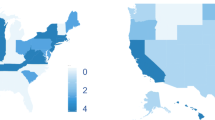Abstract
Firearm morbidity and mortality place an enormous burden on the health care enterprise and society at large. Recent research has shown strong public support for strategies to regulate firearms yet effective federal legislation to control the types of firearms sold, conditions of sale and purchase, limitation in transportation and storage, and responsibility for use of personally owned firearms has been limited. Thus the purpose of this study was to evaluate the relationship between Congressional voting on firearm control legislation and the following: political affiliation, military service, geographic location of representation, education level, sex, and gun rights and gun control contributions. This was accomplished using a retrospective assessment of Congressional voting records from the 103rd–106th Congresses (1993–2000) regarding firearm control legislation. The study found that $6,270,553 was donated to members of Congress, $5,394,049 to members of the House and $876,504 to members of the Senate by groups concerned with firearm legislation. In the House, males (Odds Ratio [OR], 3.87), Republicans (OR, 13), those from the South (OR, 5), and those who received gun rights funds (OR, 13 to 203, depending on level of donations) were more likely to vote pro gun rights. In the Senate, support for gun rights occurred more often for those from the West (OR, 3.56), Republicans (OR, 130.50), or those who had received gun rights donations (OR, 28.00). This study has found a strong and consistent relationship between a Congressional member's position on firearm legislation and the amount of money received, political affiliation, and geographic location of representation.
Similar content being viewed by others
REFERENCES
Cook PJ, Ludwig J. Guns in America: national survey on private ownership and use of firearms. National Institute of Justice Research Brief. May 1997, pp. 1–12.
Miller M, Hemenway D. The relationship between firearms and suicide: a review of the literature. Aggression and Violent Behavior: A Review Journal 1999; 4:59–75.
Miller M, Azrael D, Hemenway D. Firearm availability and unintentional firearm deaths. Accident Analysis and Prevention 2001; 33:477–484.
Murphy SL. Deaths: Final Data for 1998. National vital statistics reports. 2000; 48(11). Hyattsville, Maryland: National Center for Health Statistics.
Kreg EG, Powell KE, Dahlberg LL. Firearm-related deaths in the United States and 35 other highand upper-middle income countries. Epidemiology 1998; 27:214–221.
Centers for Disease Control and Prevention: Rates of homicide, suicide, and firearm-related death among children-26 industrialized countries. MMWR1997; 46:101–105.
Annest JL, Mercy JA, Gibson DR, Ryan GA. National estimates of nonfatal firearm-related injuries: beyond the tip of the iceberg. JAMA 1995; 273:1749–1754.
Cook PJ, Lawerence BA, Ludwig J, Miller TR. The medical costs of gunshot injuries in the United States. JAMA 1999; 282:447–454.
Winett LB. Constructing violence as a public health problem. Public Health Rep 1998; 113:498–507.
Teret SP, Webster DW, Vernick JS, et al. Support for new policies to regulate firearms-results of two national surveys. N Engl J Med 1998; 339:813–818.
Blendon RJ, Young JT, Hemenway D. The American public health and the gun control debate. JAMA 1996; 275:1719–1722.
Frank E, Kellerman A. Firearm ownership among female physicians in the United States. South Med J 1999; 92:1083–1088.
Ludwig J, Cook PJ, Smith TW. The gender gap on reporting household gun ownership. Am J Public Health 1998; 88:1715–1718.
Center for Responsible Politics. Gun Rights Recipients. Available at: http://www.opensecrets.org/ industries/recips.asp?Ind=Q13. Accessed December 27, 2000.
Center for Responsible Politics. Gun Control Recipients. Available at: http://www.opensecrets.org/ industries/recips.asp?Ind=Q12. Accessed December 29, 2000.
Barone M, Ujifusa G. The Almanac of American Politics 1994. Washington DC: National Journal Group Inc., 1993.
Barone M, Cohen, RE. The Almanac of American Politics 2000. Washington DC: National Journal Group Inc., 1999.
Handgun Control Inc. United States Senate voting records on key gun issues (1987–1999). Available at: http://www.handguncontrol.org/fedleg/svotes.asp. Accessed January 3, 2001.
Handgun Control Inc. U.S. House of Representatives voting records on key gun issues (1988– 1999). Available at: http://www.handguncontrol.org/fedleg/hvotes.asp. Accessed January 3, 2001.
United States Senate. Legislative Activities. Senate Roll Call Votes. Available at: http://www. senate.gov/legislative/legis_act_rollcall.html. Accessed January 3, 2001.
United States House of Representative. The Office of the Clerk. Legislative Activities. U.S. House of Representatives Roll Call Votes. Available at: http://clerkweb.house.gov/evs/index105.htm. Accessed January 5, 2001.
MacKay AP, Fingerhut LA, Duran CR. Adolescent Health Chartbook. Health, United States, 2000. Hyattsville, Maryland: National Center for Health Statistics, 2000.
Stratmann T. The market for congressional votes: Is timing of contributions everything? J Law Econ 1998; 41:85–113.
Stratmann T. What do campaign contributions buy? Deciphering causal effects of money and votes. S Econ J 1991; 57:606–620.
Moore S, Wolfe SM, Lindes D, & Douglas CE. Epidemiology of failed tobacco control legislation. JAMA 1994; 272:1171–1175.
Hemenway D. Regulation of firearms. N Engl J Med 1998; 339:843–845.
Bronars SG & Lott JR. Do campaign contributions alter how a politician votes? Or, do donors support candidates who value the same things they do? J Law Econ 1997; 40:317–350.
Author information
Authors and Affiliations
Corresponding author
Rights and permissions
About this article
Cite this article
Price, J.H., Dake, J.A. & Thompson, A.J. Congressional Voting Behavior on Firearm Control Legislation: 1993–2000. Journal of Community Health 27, 419–432 (2002). https://doi.org/10.1023/A:1020601218452
Issue Date:
DOI: https://doi.org/10.1023/A:1020601218452



